|
Dutch
Barn Preservation Society
Dedicated
to the Study and Preservation
of New World Dutch Barns
Newsletter,
FALL 1990, Vol. 3, Issue 2
The
Larger Wemp Barn
By Vincent Schaefer
This Dutch barn of Fort Hunter, Montgomery County,
NY, one of the finest of the pre-Revolutionary period, has been
sold, dismantled, and reerected at a site along the Onesquethaw
Creek, in the Town of New Scotland, in Albany County. Despite four
separate attempts to keep the barn at its original site, all efforts
failed.
More than fifty years ago I first visited the Larger Wemp Barn.
I believe I was told about it by my old friend, Robert Hartley,
a local farmer and historian of the township of Florida. I was
much impressed with the beauty and workmanship of the barn, which
at that time was an important part of a working farm. Over the
years, I visited the barn occasionally and when the farm was no
longer a productive operation, I became apprehensive, since so
many of the barns were disappearing due to arson, fires from spontaneous
combustion, or neglect. Several holes developed in the slate roof
of the barn, and an inspection early last year disclosed that the
barn was headed for serious deterioration. The owner decided to
sell it. Hoping the barn could be retained on the site, proposals,
both to the owner and to New York State, which owns an adjoining
historic site, were made to avoid moving the barn, but all were
turned down.
With this threat of our state losing one of the finest remaining
links to the pioneer days of the Mohawk Valley, I renewed my effort
to get one of my friends to acquire the barn. Carl Touhey was looking
for a Dutch barn to complement his historic limestone home, built
by the Van Zandts in 1754. Fortunately, he agreed, and the barn
was purchased by Carl at the end of 1989.
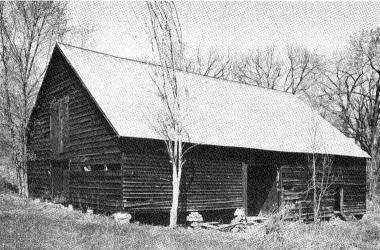 The
Larger Wemp Barn at its former location at Fort Hunter. The side
entrance and an extension (at left) had been added. The barn
was erected at an unknown date, on land obtained by Johannes
(Jan) Wemp and deeded to him by the Mohawk Indians in 1736. It
was reputedly spared from burning during the Revolution because
the owner at the tim,e, Wemp's grandson, Andries, was a Tory.
Later, after the construction of the Erie Canal in 1825; the
barn was used for storing straw and hay for mules hauling barges
on the canal. The
Larger Wemp Barn at its former location at Fort Hunter. The side
entrance and an extension (at left) had been added. The barn
was erected at an unknown date, on land obtained by Johannes
(Jan) Wemp and deeded to him by the Mohawk Indians in 1736. It
was reputedly spared from burning during the Revolution because
the owner at the tim,e, Wemp's grandson, Andries, was a Tory.
Later, after the construction of the Erie Canal in 1825; the
barn was used for storing straw and hay for mules hauling barges
on the canal.
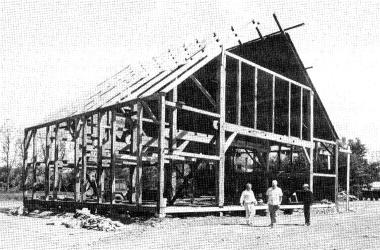
The barn in the process of being re-erected on
the new site. The holes for pentice supports are clearly visible.
Vincent Schaefer, center, Richard Babcock, barn contractor, and
Donald Sawyer are shown.
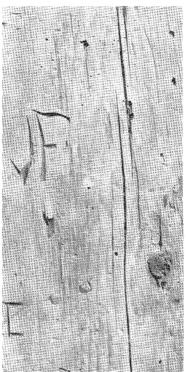 The
initials "JF" are located on a post in the barn. The
date, 1794, found on a stud under siding high in the gable, may
indicate the barn was moved or re-sided at that time. The
initials "JF" are located on a post in the barn. The
date, 1794, found on a stud under siding high in the gable, may
indicate the barn was moved or re-sided at that time.
Work was started by the barn movers, Richard Babcock and his
sons, Clayton and Charles, toward the end of March, 1990. Despite
snow, rain and wind, the slate roof (not original) was salvaged,
the roof rafters removed, and in less than a month, all the timbers
were disassembled. Much of this work was done using a gin pole,
the same mechanism probably used in erecting the barn. [For a discussion
of this procedure, see John Fitchen, The New World Dutch Barn,
Syracuse University Press, 1968, 55.] During the month of May,
a foundation and piers were prepared in a five acre meadow close
to the Touheys' home on the Onesquethaw Creek near the hamlet of
Feura Bush, and erection of the barn proceeded with dispatch. By
mid-June most of the barn was up and the slate roof and the floor
were well under way.
The barn was dedicated with ceremonies and festivities attended
by a large crowd in conjunction with the Annual Meeting of the
Dutch Barn Preservation Society, on October 13, 1990. A certificate
of appreciation was presented to Carl Touhey by the Trustees of
the Society. Looking to the future, Carl has stated that he and
his family intend to make the barn available to succeeding generations.
It is likely that it will become a museum and a site for special
public programs.
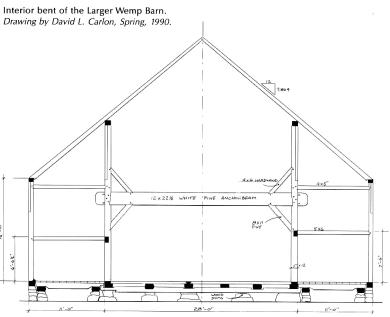
Interior bent of the Larger Wemp
Barn. Drawing by David L. Carlon, Spring, 1990.
With its newly laid slate roof, new piers and sills, and ancient
solid timbers and floor, the Larger Wemp Barn should last for centuries
into the future, to serve as a link between the pioneer days of
eastern New York and the developing cultures of the twenty-first
century.
The author, Director Emeritus of the Atmospheric
Sciences Research Center, State University of New York, is
a Dutch Barn Preservation Society Trustee. Photos by Clarke
Blair.
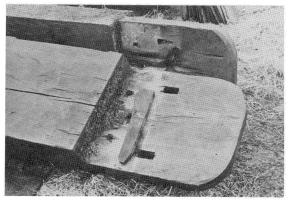
A small oak wedge, used to secure the anchorbeam
to the post, lies on the anchorbeam in foreground. The anchorbeams,
of pine, were 22" x 11". The skillfully chamfered tongue
is shown as are three holes for pegs and two for wedges. The
50' wide, 45' deep barn is notable for its craftsmanship.
FALL 1990 Newsletter, Part TWO
|